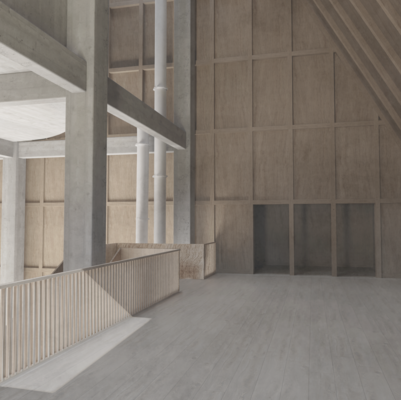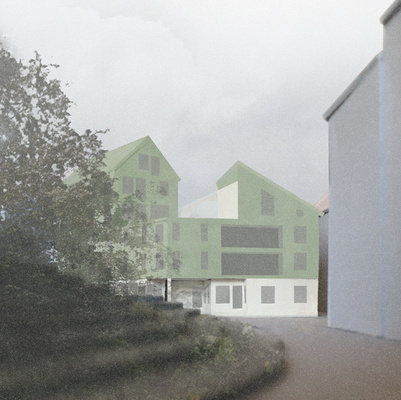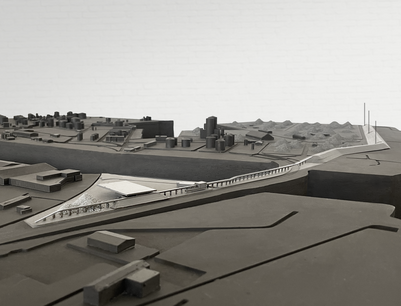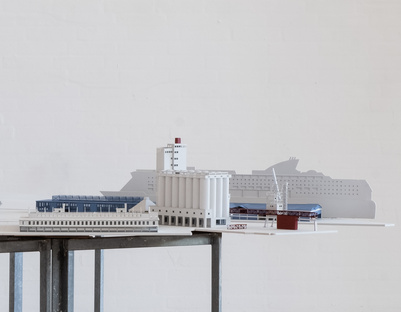Ringholmen Island
"Meeting Place in the Sea"
A small, culturally historic island in Norway is being further developed with 3 new expansions to preserve and strengthen its role as the "Meeting Place in the Sea", an important role since the start of the Clipfish Adventure in the 1600s.
1. The Fishing House
2. The Storm House
3. Cabins
The challenge of settling close to the mighty ocean and the fragile landscape has been an important focal point for a frugal and sustainable impact on nature.
But in order to approach and work with such a sensitive place, we had to ask ourselves an important question:
Where is the line between when you do too much and you do too little?

This project is a collaboration with Marte Jensen Birkeland.
Drawings are attached.
A big thank you to Ringholmen Sjøhus for fantastic help, openness, hospitality, and an unforgettable stay. We hope you like our suggestion.
History
New functions have moved into historical buildings. What used to be an important part of Norwegian fishing industry has become a hotel called Ringholmen Sjøhus, as well as private cabins owned by locals. Historically, what was a meeting place for fishing boats, hardworking women and their children, is today an important and popular social meeting place for the locals.
Quote from local resident in Norwegian, discussing its important role today:
"Her har mange ekteskap og forhold starta og slutta opp gjennom åra, skal eg seia deg! Det finst nesten ikkje eit menneske rundt her som ikkje har ein nær relasjon til Ringholmen på godt og vondt. (...)”
(Lønning, D. J., Evans, R. (2010) ”Fellesskapsturisme” Høgskulen for Landbrug og Bygdenæringar)
Strategy
We've worked to create what's necessary, but still enough to be able to improve the amount of life, further develop and promote Ringholmen as the "Meeting Place in the Sea".
Our strategy was built on a report "Fellesskapsturisme" (translate: Community tourism), which researches how to best secure the island´s future development. According to the report, we must focus on, and include, 2 user groups: the locals and the traveling Norwegians. It's important to promote Ringholmen as a common property, where nature is equally available to everyone, as well as to oppose privatization.
Unfortunately, the traces of the past are disappearing in step with their economy and plan for the future, which consists developing numbers of private cabins that privatize the coastline, and thus also the connection to Sjøhuset and its important role. Therefore we offer a new and more frugal proposal that addresses the report's values.

Location
Ringholmen is located on the edge of the Atlantic Ocean in midwest Norway. It's protected against the worst winds and sea forces by two north-facing islands, that we use for our project.
We're connecting these islands by a sustainable, cable ferry, crossing the inner sea space and is connected to two floating docks on either side that follows the tide.It takes little attention but allows a greater approach to the water and its qualities.

1. The Fishing House
The first expansion functions as a social meeting place, primarily for the locals, but also travelers in general. It’s a social place for fishing where you can rent a small boat, fish, clean, and cut your freshly caught fish. The Fishing House is the first thing you’ll see when you sail towards the island and becomes a new first impression, unlike today’s messy area. An extension of the main quay and Sjøhuset.
The functional use of the building provided the starting point for the design with inspiration from traditional and local boathouse typologies. The location and house give you direct access to the boats and sea, and where one room follows more functions. The wooden structure and the practical swallow corridors, provide a place to dry fish, nets, and store fishing tackle.
When it’s not in use the house is closed and anonymous to secure and weatherproof. But when the facade of wooden shutters and big doors folds open, it allows you to see right through the interior. It connects inside and outside and emphasizes social meetings.
An existing steel frame, rocks, and concrete are used for the foundation. On top, it has a concrete floor with a high plinth to secure and protect the timber structure. Ore pine panels line the interior and exterior and the roof is covered with a layer of reused red zinc which refers to the red details at Sjøhuset and Nausterne. A functional house with simple materials.




2. The Storm House
The second addition functions as a social hinge between east and west and enlarges the recreation area at Ringholmen. Here the focus and gaze are directed toward the storm. In this area, the strongest wind prevails from the west, where house will provide shelter for the open and flat area behind. You can be inside and in complete contact with the view and the storm, or open the doors when the weather permits and become one with the square.
The house connects to Ringholmen´s main path and becomes a natural stopping point for visitors and hikers. From the natural and local stone plinth, grows a stone oven that can light up when visitors enter the house and gather around the long table to eat their packed lunches, experience the storm in a safe setting, or for events.
The house stands robustly on its stone foundation which continues up the rocks and forms a plinth which is used for seating under the large overhang and refers to a sailing mark which is the island´s oldest symbol. The house speaks to the Fishing House and Cabins in its typology, materiality, and design, referring to local qualities.
The construction consists of oversized columns and rafters to emphasize its robust role as a storm house. The robustness is emphasized with a roof of natural and local slate stone. In front of the windows, seating spaces are created, with the possibility of storage such as blankets and firewood.



3. Cabins
The third impact is 6 tiny cabins designed to connect its users with nature. A retreat into nature, as most Norwegians love to do on their weekends. An important part of their culture. The cabins are compact and take minimal footprint as well as they intend to blend into the terrain and integrate with nature.
The rocky landscape at Nordskjæret near the mighty sea, was a driving force in every aspect. Each cabin has its own specific and unique location, which is carefully selected based on the chaotic rocky terrain, and special views. Each cabin has a main view that defines the inner space, with additional views focusing on the qualities of the landscape, creating little glances, niches, and a close connection to nature. Some were placed higher with a greater overview, and some closer to the sea and more exposed. Therefore, if one moves, all move.
The interior plans are flexible piece of furniture that offers accommodation in different ways based on the user and the views.
The cabins are raised above the rocks on timber pillars to minimize disruption to the site. The exterior is entirely wrapped in untreated ore pine (malmfuru), which is maintenance-free and naturally impregnated by the salt from the sea. Over time it weathers, turns gray, and reflects the colors of the rocks. Reused pinewood panels line the interior, to promote closeness to nature and create a safe and warm atmosphere. Where necessary, we use zinc to protect the wood.




If you have further interest in Ringholmen Sjøhus, link to their website is: https://www.ringholmen.no






























































